2005 SUBARU FORESTER suspension
[x] Cancel search: suspensionPage 67 of 477
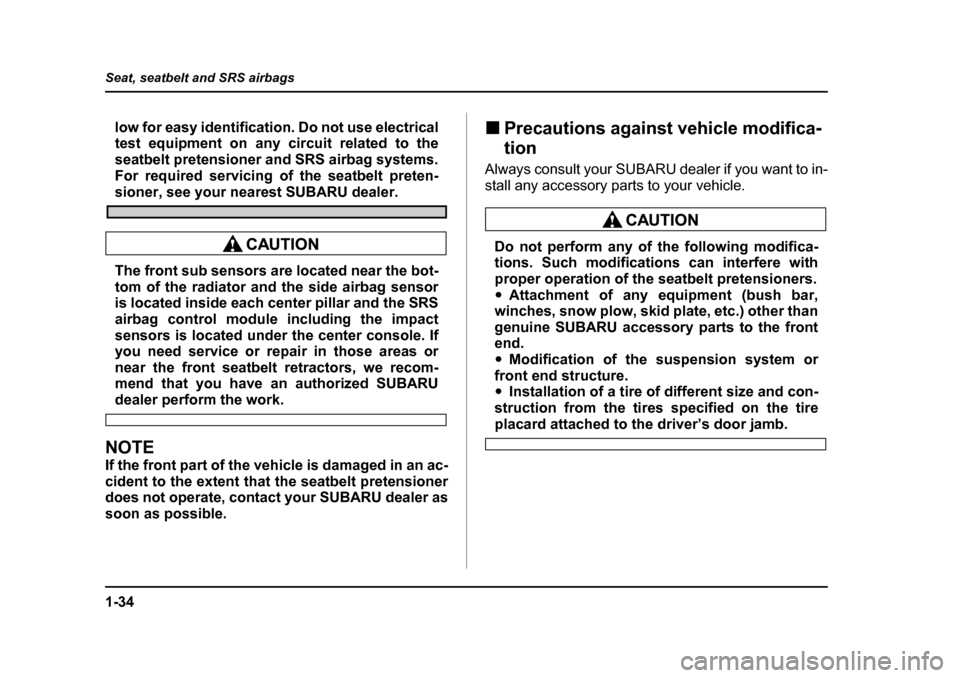
1-34
Seat, seatbelt and SRS airbags
low for easy identification. Do not use electrical
test equipment on any circuit related to the
seatbelt pretensioner and SRS airbag systems.
For required servicing of the seatbelt preten-
sioner, see your nearest SUBARU dealer.
The front sub sensors are located near the bot-
tom of the radiator and the side airbag sensor
is located inside each center pillar and the SRS
airbag control module including the impact
sensors is located under the center console. If
you need service or repair in those areas or
near the front seatbelt retractors, we recom-
mend that you have an authorized SUBARU
dealer perform the work.
NOTE
If the front part of the vehicle is damaged in an ac-
cident to the extent that the seatbelt pretensioner
does not operate, contact your SUBARU dealer as
soon as possible.
�„
Precautions against vehicle modifica- tion
Always consult your SUBARU dealer if you want to in-
stall any accessory parts to your vehicle.
Do not perform any of the following modifica-
tions. Such modifications can interfere with
proper operation of the seatbelt pretensioners.�y Attachment of any equipment (bush bar,
winches, snow plow, skid plate, etc.) other than
genuine SUBARU accessory parts to the front
end. �y Modification of the suspension system or
front end structure. �y Installation of a tire of different size and con-
struction from the tires specified on the tire
placard attached to the driver’s door jamb.
Page 109 of 477
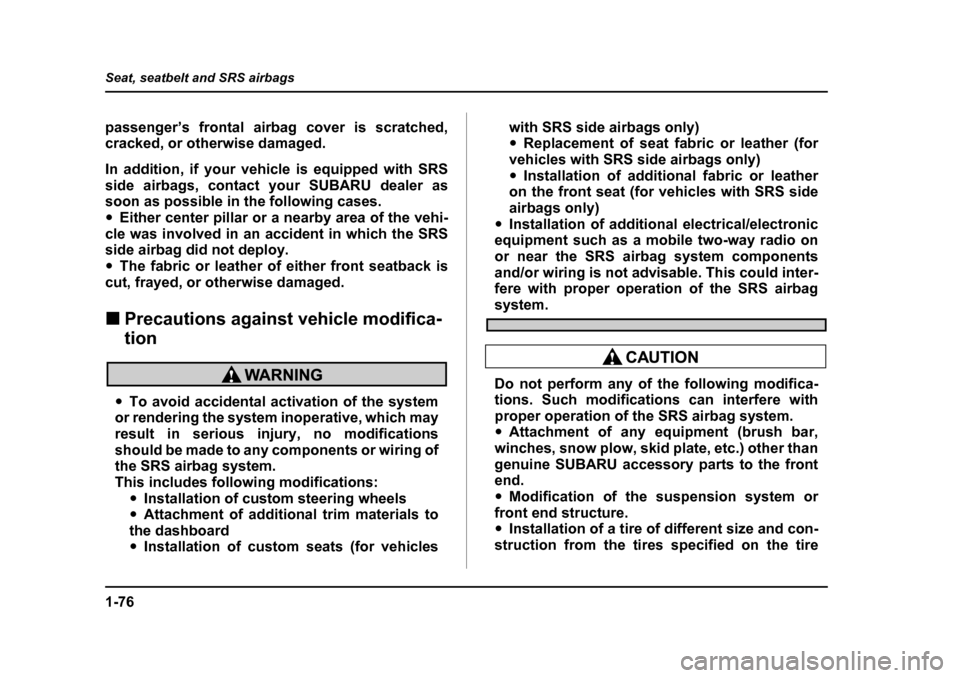
1-76
Seat, seatbelt and SRS airbags
passenger’s frontal airbag cover is scratched,
cracked, or otherwise damaged.
In addition, if your vehicle is equipped with SRS
side airbags, contact your SUBARU dealer as
soon as possible in the following cases.�y
Either center pillar or a nearby area of the vehi-
cle was involved in an accident in which the SRS
side airbag did not deploy.�y The fabric or leather of either front seatback is
cut, frayed, or otherwise damaged. �„ Precautions against vehicle modifica- tion
�yTo avoid accidental activation of the system
or rendering the system inoperative, which may
result in serious injury, no modifications
should be made to any components or wiring of
the SRS airbag system.
This includes following modifications: �yInstallation of custom steering wheels
�y Attachment of additional trim materials to
the dashboard �y Installation of custom seats (for vehicles with SRS side airbags only)�y
Replacement of seat fabric or leather (for
vehicles with SRS side airbags only) �y Installation of additional fabric or leather
on the front seat (for vehicles with SRS side
airbags only)
�y Installation of additional electrical/electronic
equipment such as a mobile two-way radio on
or near the SRS airbag system components
and/or wiring is not advisable. This could inter-
fere with proper operation of the SRS airbag
system.
Do not perform any of the following modifica-
tions. Such modifications can interfere with
proper operation of the SRS airbag system. �y Attachment of any equipment (brush bar,
winches, snow plow, skid plate, etc.) other than
genuine SUBARU accessory parts to the front
end. �y Modification of the suspension system or
front end structure. �y Installation of a tire of different size and con-
struction from the tires specified on the tire
Page 258 of 477

7-1
7
Starting and operating
Fuel ................................................................ 7-2 Fuel requirements ............................................. 7-2
Fuel filler lid and cap ........................................ 7-4
State emission testing (U.S. only) ............... 7-7
Preparing to drive ......................................... 7-9
Starting the engine ....................................... 7-9 Manual transmission vehicle ........................... 7-9
Automatic transmission vehicle ...................... 7-10
Stopping the engine ..................................... 7-12
Manual transmission .................................... 7-12 Shifting speeds ................................................. 7-13
Driving tips ........................................................ 7-14
Automatic transmission ............................... 7-15 Selector lever for automatic transmission ..... 7-16
Shift lock release .............................................. 7-20
Rear viscous limited slip differential (LSD) (if equipped) .................................... 7-21
Power steering .............................................. 7-21
Braking .......................................................... 7-22 Braking tips ....................................................... 7-22
Brake system ..................................................... 7-22
Disc brake pad wear warning indicators ........ 7-23
ABS (Anti-lock Brake System) .................... 7-23 ABS system self-check .................................... 7-24
ABS warning light ............................................. 7-24
Electronic Brake Force Distribution (EBD) system (if equipped) ...................... 7-26Steps to take if EBD system fails .................... 7-26 Vehicle Dynamics Control system
(if equipped) ............................................... 7-28Vehicle Dynamics Control system monitor .... 7-30
Vehicle Dynamics Control OFF switch ........... 7-33
Parking your vehicle ..................................... 7-34 Parking brake .................................................... 7-34
Parking tips ....................................................... 7-34
Hill holder (for manual transmission – if equipped) ................................................ 7-36
Cruise control (if equipped) ......................... 7-38 To set cruise control ........................................ 7-38
To temporarily cancel the cruise control ....... 7-40
To turn off the cruise control ........................... 7-41
To change the cruising speed ......................... 7-41
Self-leveling rear suspension (if equipped) ............................................... 7-43
Page 285 of 477
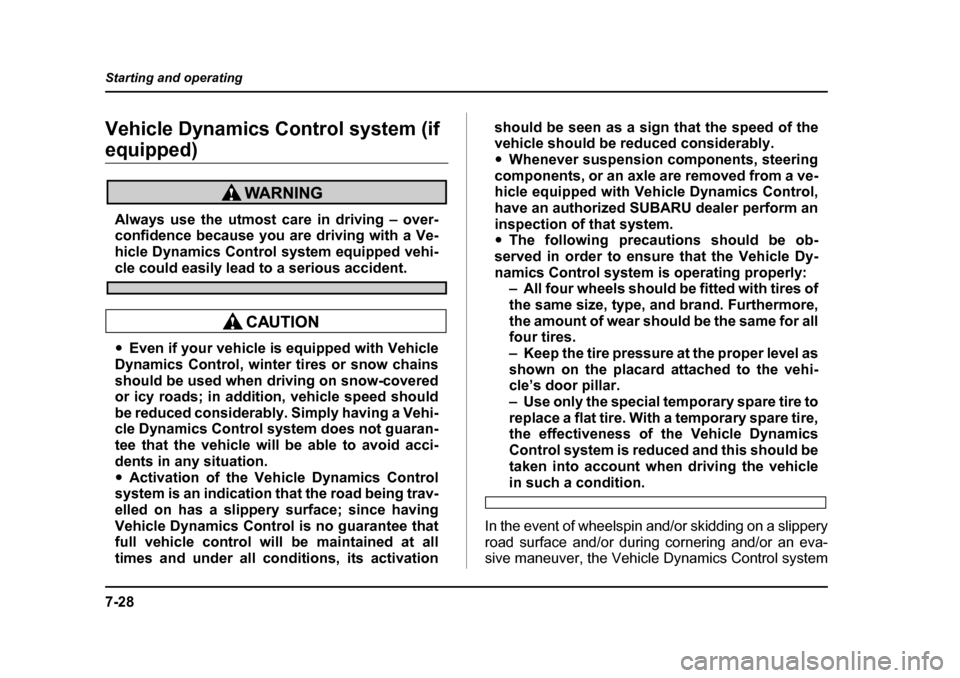
7-28
Starting and operating
Vehicle Dynamics Control system (if
equipped)
Always use the utmost care in driving – over-
confidence because you are driving with a Ve-
hicle Dynamics Control system equipped vehi-
cle could easily lead to a serious accident.
�y
Even if your vehicle is equipped with Vehicle
Dynamics Control, winter tires or snow chains
should be used when driving on snow-covered
or icy roads; in addition, vehicle speed should
be reduced considerably. Simply having a Vehi-
cle Dynamics Control system does not guaran-
tee that the vehicle will be able to avoid acci-
dents in any situation.�y Activation of the Vehicle Dynamics Control
system is an indication that the road being trav-
elled on has a slippery surface; since having
Vehicle Dynamics Control is no guarantee that
full vehicle control will be maintained at all
times and under all conditions, its activation should be seen as a sign that the speed of the
vehicle should be reduced considerably.�y
Whenever suspension components, steering
components, or an axle are removed from a ve-
hicle equipped with Vehicle Dynamics Control,
have an authorized SUBARU dealer perform an
inspection of that system. �y The following precautions should be ob-
served in order to ensure that the Vehicle Dy-
namics Control system is operating properly: – All four wheels should be fitted with tires of
the same size, type, and brand. Furthermore,
the amount of wear should be the same for all four tires.
– Keep the tire pressure at the proper level as
shown on the placard attached to the vehi-
cle’s door pillar.
– Use only the special temporary spare tire to
replace a flat tire. With a temporary spare tire,
the effectiveness of the Vehicle Dynamics
Control system is reduced and this should be
taken into account when driving the vehicle
in such a condition.
In the event of wheelspin and/or skidding on a slippery
road surface and/or during cornering and/or an eva-
sive maneuver, the Vehicle Dynamics Control system
Page 300 of 477
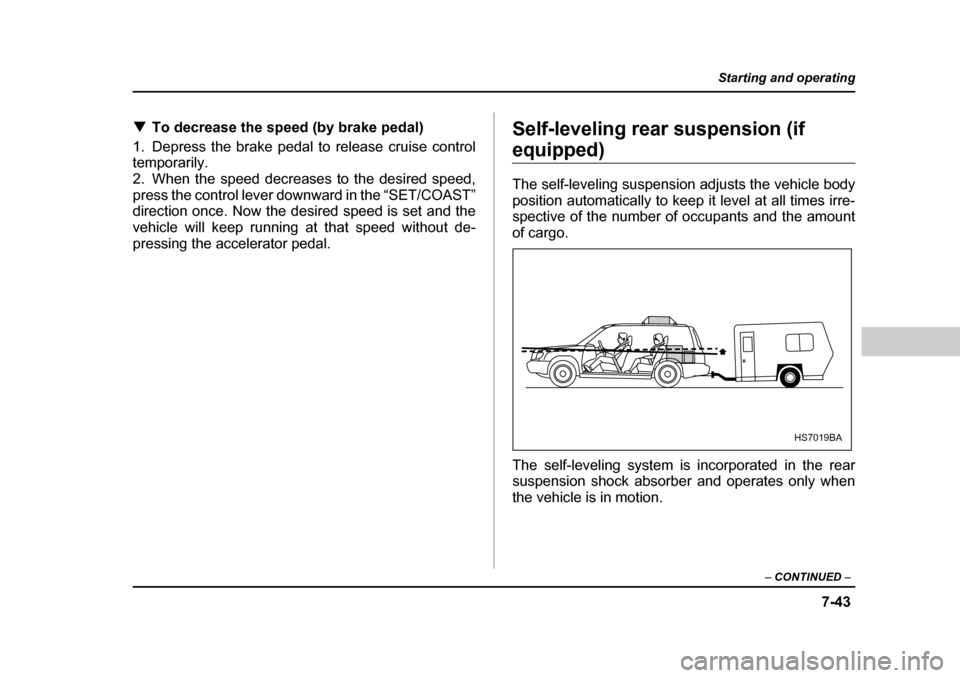
7-43
Starting and operating
– CONTINUED –
�TTo decrease the speed (by brake pedal)
1. Depress the brake pedal to release cruise control
temporarily.
2. When the speed decreases to the desired speed,
press the control lever downward in the “SET/COAST”
direction once. Now the desired speed is set and the
vehicle will keep running at that speed without de-
pressing the accelerator pedal. Self-leveling rear suspension (if
equipped)
The self-leveling suspension adjusts the vehicle body
position automatically to keep it level at all times irre-
spective of the number of occupants and the amount
of cargo.
The self-leveling system is incorporated in the rear
suspension shock absorber and operates only when
the vehicle is in motion.
HS7019BA
Page 301 of 477
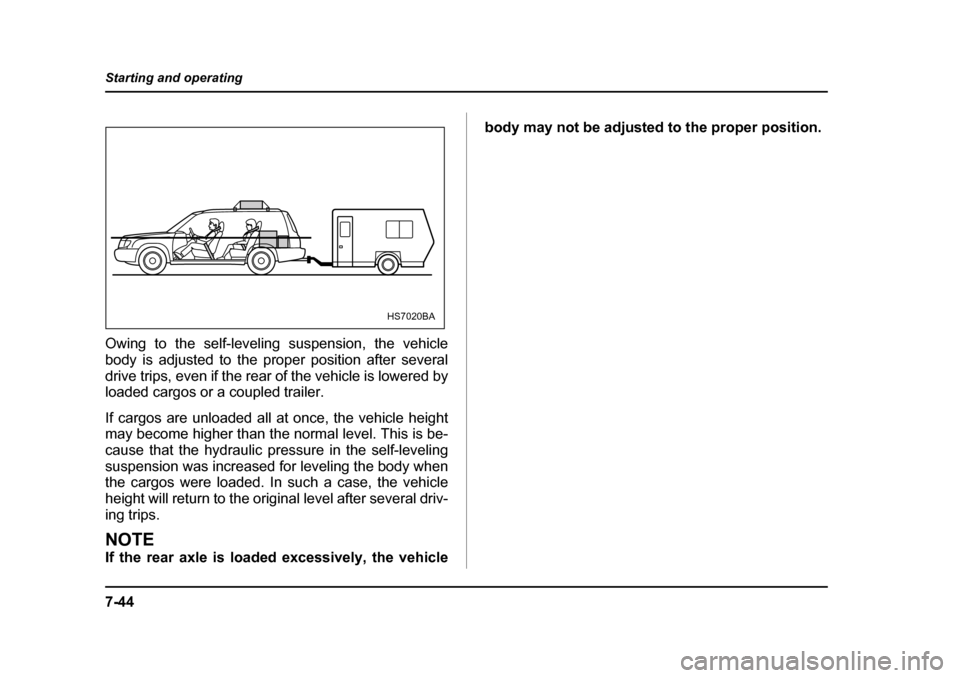
7-44
Starting and operating
Owing to the self-leveling suspension, the vehicle
body is adjusted to the proper position after several
drive trips, even if the rear of the vehicle is lowered by
loaded cargos or a coupled trailer.
If cargos are unloaded all at once, the vehicle height
may become higher than the normal level. This is be-
cause that the hydraulic pressure in the self-leveling
suspension was increased for leveling the body when
the cargos were loaded. In such a case, the vehicle
height will return to the original level after several driv-
ing trips.
NOTE
If the rear axle is loaded excessively, the vehicle
body may not be adjusted to the proper position.
HS7020BA
Page 310 of 477

8-9
Driving tips
– CONTINUED –
could create a fire hazard. �yAfter driving through tall grass, mud, rocks, sand,
rivers, etc., check that there is no grass, bush, paper,
rags, stones, sand, etc. adhering to or trapped on the
underbody. Clear off any such matter from the under-
body. If the vehicle is used with these materials
trapped or adhering to the underbody, a mechanical
breakdown or fire could occur.�y Secure all cargo carried inside the vehicle and make
certain that it is not piled higher than the seatbacks.
During sudden stops or jolts, unsecured cargo could
be thrown around in the vehicle and cause injury. Do
not pile heavy loads on the roof. Those loads raise the
vehicle’s center of gravity and make it more prone to
tip over. �y If you must rock the vehicle to free it from sand or
mud, depress the accelerator pedal slightly and move
the selector lever back and forth between “D” and “R”
repeatedly. Do not race the engine. For the best pos-
sible traction, avoid spinning the wheels when trying to
free the vehicle.
When the road surface is extremely slippery, you can
obtain better traction by starting the vehicle with the
transmission in 2nd than 1st (both for MT and AT). �y Never equip your vehicle with tires larger than those
specified in this manual. �y Frequent driving of an AWD vehicle under hard-driv- ing conditions such as rough roads or off roads will ne-
cessitate more frequent replacement of engine oil,
brake fluid and transmission oil than that specified in
the maintenance schedule described in the “Warranty
and Maintenance Booklet”.
Remember that damage done to your SUBARU while
operating it off-road and not using common sense pre-
cautions such as those listed above is not eligible forwarranty coverage. �y
Wash the vehicle’s underbody after off-road driving.
Suspension components are particularly prone to dirt
buildup, so they need to be washed thoroughly.
�y Always maintain a safe driving speed accord-
ing to the road and weather conditions in order
to avoid having an accident on a sharp turn,
during sudden braking or under other similar
conditions.�y Always use the utmost care in driving – over-
confidence because you are driving an All-
Wheel Drive vehicle could easily lead to a seri-
ous accident.
Page 312 of 477
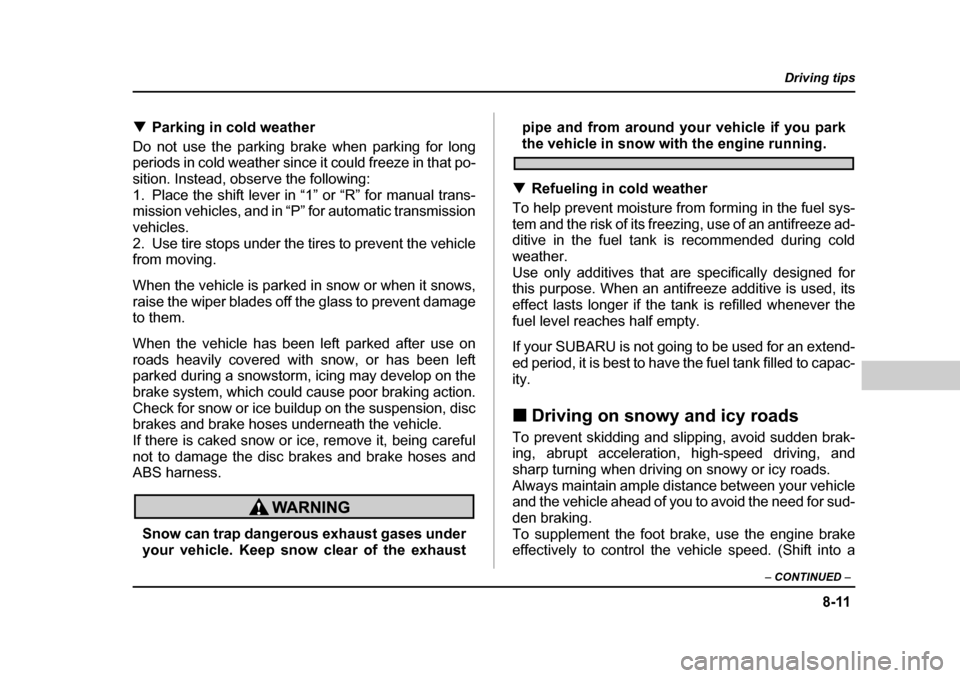
8-11
Driving tips
– CONTINUED –
�TParking in cold weather
Do not use the parking brake when parking for long
periods in cold weather since it could freeze in that po-
sition. Instead, observe the following:
1. Place the shift lever in “1” or “R” for manual trans-
mission vehicles, and in “P” for automatic transmissionvehicles.
2. Use tire stops under the tires to prevent the vehicle
from moving.
When the vehicle is parked in snow or when it snows,
raise the wiper blades off the glass to prevent damage to them.
When the vehicle has been left parked after use on
roads heavily covered with snow, or has been left
parked during a snowstorm, icing may develop on the
brake system, which could cause poor braking action.
Check for snow or ice buildup on the suspension, disc
brakes and brake hoses underneath the vehicle.
If there is caked snow or ice, remove it, being careful
not to damage the disc brakes and brake hoses and ABS harness.
Snow can trap dangerous exhaust gases under
your vehicle. Keep snow clear of the exhaust pipe and from around your vehicle if you park
the vehicle in snow with the engine running.
�T Refueling in cold weather
To help prevent moisture from forming in the fuel sys-
tem and the risk of its freezing, use of an antifreeze ad-
ditive in the fuel tank is recommended during cold
weather.
Use only additives that are specifically designed for
this purpose. When an antifreeze additive is used, its
effect lasts longer if the tank is refilled whenever the
fuel level reaches half empty.
If your SUBARU is not going to be used for an extend-
ed period, it is best to have the fuel tank filled to capac- ity. �„ Driving on snowy and icy roads
To prevent skidding and slipping, avoid sudden brak-
ing, abrupt acceleration, high-speed driving, and
sharp turning when driving on snowy or icy roads.
Always maintain ample distance between your vehicle
and the vehicle ahead of you to avoid the need for sud-
den braking.
To supplement the foot brake, use the engine brake
effectively to control the vehicle speed. (Shift into a